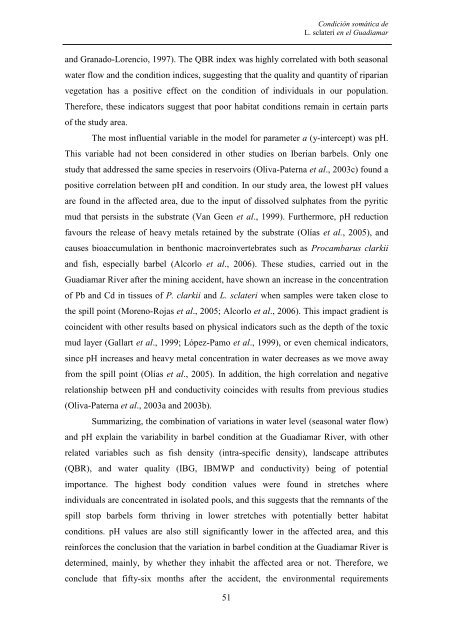las comunidades de peces del río guadiamar y el accidente minero ...
las comunidades de peces del río guadiamar y el accidente minero ...
las comunidades de peces del río guadiamar y el accidente minero ...
Create successful ePaper yourself
Turn your PDF publications into a flip-book with our unique Google optimized e-Paper software.
Condición somática <strong>de</strong><br />
L. sclateri en <strong>el</strong> Guadiamar<br />
and Granado-Lorencio, 1997). The QBR in<strong>de</strong>x was highly corr<strong>el</strong>ated with both seasonal<br />
water flow and the condition indices, suggesting that the quality and quantity of riparian<br />
vegetation has a positive effect on the condition of individuals in our population.<br />
Therefore, these indicators suggest that poor habitat conditions remain in certain parts<br />
of the study area.<br />
The most influential variable in the mo<strong>de</strong>l for parameter a (y-intercept) was pH.<br />
This variable had not been consi<strong>de</strong>red in other studies on Iberian barb<strong>el</strong>s. Only one<br />
study that addressed the same species in reservoirs (Oliva-Paterna et al., 2003c) found a<br />
positive corr<strong>el</strong>ation between pH and condition. In our study area, the lowest pH values<br />
are found in the affected area, due to the input of dissolved sulphates from the pyritic<br />
mud that persists in the substrate (Van Geen et al., 1999). Furthermore, pH reduction<br />
favours the r<strong>el</strong>ease of heavy metals retained by the substrate (Olías et al., 2005), and<br />
causes bioaccumulation in benthonic macroinvertebrates such as Procambarus clarkii<br />
and fish, especially barb<strong>el</strong> (Alcorlo et al., 2006). These studies, carried out in the<br />
Guadiamar River after the mining acci<strong>de</strong>nt, have shown an increase in the concentration<br />
of Pb and Cd in tissues of P. clarkii and L. sclateri when samples were taken close to<br />
the spill point (Moreno-Rojas et al., 2005; Alcorlo et al., 2006). This impact gradient is<br />
coinci<strong>de</strong>nt with other results based on physical indicators such as the <strong>de</strong>pth of the toxic<br />
mud layer (Gallart et al., 1999; López-Pamo et al., 1999), or even chemical indicators,<br />
since pH increases and heavy metal concentration in water <strong>de</strong>creases as we move away<br />
from the spill point (Olías et al., 2005). In addition, the high corr<strong>el</strong>ation and negative<br />
r<strong>el</strong>ationship between pH and conductivity coinci<strong>de</strong>s with results from previous studies<br />
(Oliva-Paterna et al., 2003a and 2003b).<br />
Summarizing, the combination of variations in water lev<strong>el</strong> (seasonal water flow)<br />
and pH explain the variability in barb<strong>el</strong> condition at the Guadiamar River, with other<br />
r<strong>el</strong>ated variables such as fish <strong>de</strong>nsity (intra-specific <strong>de</strong>nsity), landscape attributes<br />
(QBR), and water quality (IBG, IBMWP and conductivity) being of potential<br />
importance. The highest body condition values were found in stretches where<br />
individuals are concentrated in isolated pools, and this suggests that the remnants of the<br />
spill stop barb<strong>el</strong>s form thriving in lower stretches with potentially better habitat<br />
conditions. pH values are also still significantly lower in the affected area, and this<br />
reinforces the conclusion that the variation in barb<strong>el</strong> condition at the Guadiamar River is<br />
<strong>de</strong>termined, mainly, by whether they inhabit the affected area or not. Therefore, we<br />
conclu<strong>de</strong> that fifty-six months after the acci<strong>de</strong>nt, the environmental requirements<br />
51

















